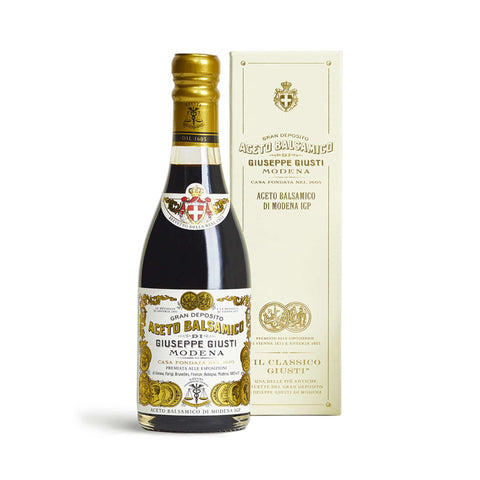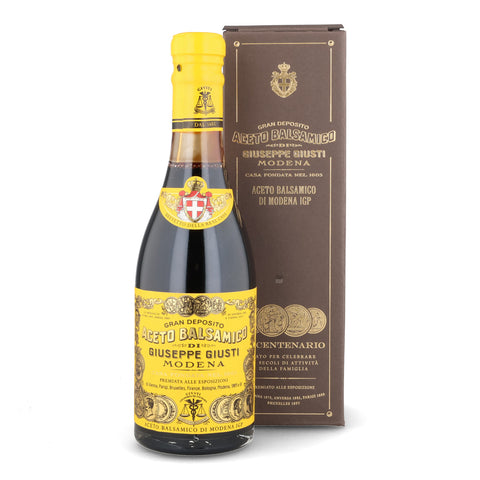Everything You Need To Know About Balsamic Vinegar
by Holly Thomson

Discover the world of balsamic vinegar, how it differs in taste, and which types are best to buy. Our guide explores traditional balsamic vinegar of Modena and Reggio Emilia, along with modern options suited for everyday use.
Balsamic vinegar is a dark, richly flavoured vinegar hailing from Italy, known for its sweet and tangy balance. Whether used in salad dressings, marinades, or drizzled over desserts, this versatile ingredient is a staple in many kitchens. But not all balsamic vinegars are the same. The ageing process, ingredients, and region play significant roles in the final taste and quality.
Learn more about the best balsamic vinegars available and how to make the most of this unique ingredient.
Read our guide to the choosing the best balsamic vinegar here.
And discover more ways to use balsamic, beyond simple salad dressings.
Shop balsamic vinegar & balsamic glaze here
What is Balsamic Vinegar?
Balsamic vinegar is a dark vinegar with a rich, complex flavour, originating from Italy. Its distinctive taste comes from the combination of sweet and tangy notes, thanks to the traditional production methods that involve ageing grape must in wooden barrels.
True traditional balsamic vinegar is produced in Modena and Reggio Emilia, where it undergoes a careful ageing process, often lasting for years or even decades. This method ensures the vinegar develops its deep, nuanced flavour. The more accessible aceto balsamico di Modena, which combines grape must with wine vinegar, is also produced in these regions and highlights the unique production process that distinguishes it from cheaper imitations.
Balsamic vinegar enhances a variety complex flavors of dishes, from fresh salads to decadent desserts, making it an essential ingredient in both professional and home kitchens.
What is Balsamic Vinegar Made From
At its core, balsamic vinegar is made from grape must – freshly crushed grape juice that includes the skins, seeds, and stems. The must is cooked down to create a thick syrup, which is then aged in a series of wooden barrels, allowing it to develop its rich flavour. The barrels are often made from different types of wood, such as oak, cherry, chestnut, or juniper, each imparting distinct characteristics to the vinegar.
Traditional balsamic vinegar is made exclusively from grape must, while modern varieties may contain a mix of grape must and wine vinegar. The latter speeds up the production process, making it more affordable, but it doesn’t achieve the same depth of flavour as traditional balsamic.
Balsamic syrup, also known as balsamic glaze, is made by reducing balsamic vinegar, often combined with sweeteners and thickeners, and is used as a versatile finishing sauce for various dishes.
How is Balsamic Vinegar Made
The process of making true balsamic vinegar begins with grape must that is cooked to a thick syrup. The syrup is then aged in wooden barrels, where it slowly ferments and concentrates over time. Each year, the vinegar is moved into smaller barrels, made from different woods to impart diverse flavours. The smallest barrels contain the most concentrated, thickest vinegar.
For true balsamic vinegar, this process can last anywhere from 12 to 25 years or longer. Authentic true balsamic vinegar, often marked with 'tradizionale' and/or DOC labels, is an artisan product from Modena, Italy. The slow evaporation through the barrel walls thickens the vinegar, giving it a syrupy texture and a complex flavour profile that balances sweet and tart notes.
Modern balsamic vinegar is made by mixing grape must with wine vinegar. This allows for quicker production, but it lacks the long-term fermentation and ageing of traditional methods, resulting in a more acidic, less complex product.
Where Does Balsamic Vinegar Come From
Balsamic vinegar originates from the regions of Modena and Reggio Emilia in Italy. These areas are renowned for their strict adherence to traditional methods that have been passed down for generations. The balsamic vinegar from these regions is protected by the European Union’s DOP (Protected Designation of Origin) status, ensuring it is produced according to specific regulations.
The unique climate in Modena and Reggio Emilia plays a vital role in the production of infused balsamic vinegar. The warm summers and cool winters allow the vinegar to mature properly as it moves through the series of barrels, absorbing flavours from the wood and evaporating to become more concentrated over time.
Additionally, the growing popularity of infused balsamic, with flavors like vine tomato, white peach, and green apple, showcases the culinary creativity and consumer interest in these unique adaptations.
How Long Does Balsamic Vinegar Last
Once opened, balsamic vinegar can maintain its best quality for three to five years if stored correctly. Keep the bottle in a cool, dark place with the cap tightly sealed to preserve its flavour and prevent oxidation. With proper storage, balsamic vinegar won’t spoil, but its flavour may deepen over time as it matures.
Avoid exposing the vinegar to heat or direct sunlight, as these can degrade its quality. When stored properly, balsamic vinegar is an ingredient that can last for years, retaining its rich taste.
What Does Balsamic Vinegar Taste Like
The taste of balsamic vinegar can vary depending on how long it’s been aged. Younger balsamic vinegar has a sharper, tangier profile, while older, traditional balsamic is smoother and sweeter with a syrupy texture. Over time, the vinegar absorbs flavours from the wood barrels, developing rich, complex notes that may include hints of fig, cherry, molasses, and even chocolate.
This unique flavour profile makes balsamic vinegar a versatile addition to both sweet and savoury dishes, enhancing everything from salads to desserts.
What Can I Use Instead of Balsamic Vinegar
If you’re out of balsamic vinegar, there are a few substitutes you can use:
-
Red Wine Vinegar with Sugar: Mix a small amount of sugar or honey with red wine vinegar to mimic balsamic’s sweet-tangy balance.
-
Apple Cider Vinegar with Molasses: Combine these for a richer alternative with a touch of sweetness.
-
Soy Sauce and Red Wine Vinegar: This blend works well for savoury dishes, providing depth and umami.
These substitutes can help achieve a similar taste in your dishes when balsamic vinegar isn’t available.
What is Balsamic Vinegar Used For
Balsamic vinegar is a versatile ingredient, suitable for a range of dishes:
-
Salad Dressings: Adds a sweet, tangy note to fresh greens.
-
Marinades: Perfect for tenderising and adding depth to meats.
-
Sauces and Glazes: Reduced to create a rich, syrupy glaze.
-
Roasted Vegetables: Enhances their natural sweetness.
-
Desserts: Drizzle over fresh fruit or ice cream for a gourmet finish.
How to Use Balsamic Vinegar
Using balsamic vinegar is straightforward and enhances many dishes. Here are the steps:
-
For salad dressing: Drizzle over fresh greens.
-
Marinades: Mix with olive oil and herbs for meats.
-
Deglazing: Add to pans after cooking meat for a rich sauce.
-
Roasted vegetables: Toss with veggies before roasting.
-
Fruits: Drizzle over fresh fruits like strawberries.
-
Glaze: Reduce to a syrup for a finishing touch on dishes.
These steps make it easy to incorporate balsamic vinegar into your cooking, adding depth and complexity to your meals.
How to Use Balsamic Vinegar in Cooking
Balsamic vinegar adds depth and complexity to various dishes. Use it in salad dressings for a sweet and tangy flavour. Add a splash to marinades for meats and vegetables to enhance their taste.
Deglaze pans with balsamic vinegar to create rich, flavorful sauces. It pairs well with roasted vegetables, adding a caramelised sweetness. Drizzle it over fresh fruits or desserts for a gourmet touch.
The versatility of balsamic vinegar makes it an essential ingredient in cooking, offering a unique flavour profile that enhances both savoury and sweet dishes.
How to Store Balsamic Vinegar
To keep balsamic vinegar fresh and flavourful, store it in a cool, dark place, tightly sealed. There’s no need to refrigerate it, and it will retain its quality at room temperature. Make sure to keep it away from heat, as high temperatures can degrade the flavour over time. Stored properly, balsamic vinegar can last for years.
What is the Best Balsamic Vinegar
The best balsamic vinegar comes from Modena or Reggio Emilia. Look for labels that say “Aceto Balsamico Tradizionale” to ensure you’re buying authentic, traditional balsamic. These vinegars are aged for at least 12 years and offer a rich, complex flavour. Some premium varieties, labelled as "extra vecchio," are aged for 25 years or more and have an even sweeter, thicker consistency.
When choosing balsamic vinegar, consider the ageing process and the quality of the ingredients. High-quality balsamic vinegar will elevate any dish with its depth of flavour.
Types of Balsamic Vinegar
8-year aged
Giusti’s 2 gold medal balsamic vinegar is a versatile balsamic, aged for a minimum of 8 years.
Giusti says "The silver medal vinegar is characterized by a rich perfume and an agreeable and rounded acidity, this is an aromatic Balsamic Vinegar enhancing the flavours of any dish thanks to its intensity. It can be used fresh or can be heated in cooking preparations."
The classic 2 gold medals balances sweet and sour flavours, with notes of black pepper, mature fruits and liquorice. This vinegar is aged in oak barrels, with the addition of aged balsamic vinegar extracted from centuries old casks.
12-year aged
Giusti’s 3 gold medal balsamic vinegar is a sweeter balsamic than others you might have tried, aged for a minimum of 12 years.
The 3 gold medals vinegar is ideal for desserts. Made from sweet, sun dried grapes, the vinegar is rich with plum jam, red fruit and vanilla flavours and aromas. The 3 gold medal vinegar has a slightly thicker texture, and works well as a marinade.
15-year aged
Common Mistakes and Myths
There are several common mistakes and myths surrounding balsamic vinegar that can lead to misunderstandings about this versatile ingredient. One of the most prevalent mistakes is assuming that all balsamic vinegars are the same. In reality, there is a wide range of balsamic vinegars, from the highly prized traditional balsamic vinegar to more affordable, industrially-produced options. Understanding the differences can help you choose the right aging traditional balsamic vinegar for your needs.
Another common myth is that balsamic vinegar is the only ingredient suitable for salad dressings. While it does add a delightful tang to salads, balsamic vinegar is incredibly versatile. It can be used to enhance the flavor of grilled meats, roasted vegetables, and even desserts. A drizzle of aged balsamic vinegar over fresh strawberries or vanilla ice cream can transform a simple dessert into a gourmet treat.
Lastly, some people believe that balsamic vinegar is too expensive to use regularly. While high-quality traditional balsamic vinegar can be pricey, it is used sparingly due to its intense flavor. A small amount can go a long way in adding depth and complexity to your dishes, making it a worthwhile investment for any kitchen. By understanding these common mistakes and myths, you can make the most of this exceptional ingredient.






